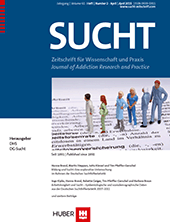Abstract
Zielsetzung: Ziel der Untersuchung war es, das Ausmaß an pathologischem Onlinespielgebrauch bei Studierenden abzuschätzen und Faktoren zu identifizieren, die mit diesem einhergehen. Methodik: Daten von 1058 Studierenden wurden erhoben. Erfasst wurden Soziodemografie, pathologischer PC-Gebrauch (OSVe-S, CIUS, IAT, ISS), Persönlichkeit (NEO-FFI-25) und psychische Belastung (SCL-90®-S). Eine Substichprobe (n = 143) von Onlinespielern wurde selegiert; Einschlusskriterium war, Onlinespiele oft bzw. sehr oft zu nutzen. Pathologisch unauffällige (n = 94) und auffällige (n = 49) Spieler wurden auf signifikante Unterschiede mittels MANOVA überprüft. Ergebnisse: Auffällige Onlinespieler waren eher männlich und länger online. Sie zeichneten sich durch höheren Neurotizismus, geringere Extraversion und stärkere psychische Belastung aus. Private Onlinezeit am Wochenende und Zwanghaftigkeit waren im multivariaten Modell signifikant mit pathologischem PC-Gebrauch assoziiert. Schlussfolgerungen: Die untersuchten Studierenden wiesen einen hohen Anteil an pathologischem PC-Gebrauch auf, vorrangig die männlichen. Weitere Studien sollten die gefundenen Zusammenhänge validieren, um gesunde und pathologische Onlinespielnutzung voneinander abzugrenzen. Es wird empfohlen, Studentenberatungen für die Thematik zu sensibilisieren.
Aim: The study estimates the amount of pathological use of online games among college students and identifies associated factors. Methods: The data of 1,058 college students was collected, including information about sociodemographics, pathological use of the computer (OSVe-S, CIUS, IAT, ISS), personality (NEO-FFI-25), and psychological distress (SCL-90®-S). A subsample of online gamers (n = 143) was selected, consisting of only those who had declared playing online games often and very often. Pathological (n = 49) and nonpathological (n = 94) users were surveyed for significant differences using MANOVA. Results: Compared to nonpathological gamers, pathological gamers were mostly male and spent more time online. They were characterized by increased neuroticism, decreased extraversion, and a higher amount of psychological distress. Time spent online on weekends for private purposes and obsessive-compulsiveness were identified as significantly associated with pathological use of the computer. Conclusions: The college students examined showed a considerable amount of pathological use of online games, especially the males. Further studies should validate these current findings to distinguish between healthy and pathological use of online games. Furthermore, it is recommended to train employees of collegiate counseling centers for this special issue.
Literatur
(2010). Problematic internet use: An overview. World Psychiatry, 9, 85 – 90.
(2013). Diagnostic and Statistical Manual of Mental Disorders, Fith Edition, DSM-5. Arlington: American Psychiatric Publishing.
(2009). Pathologischer Mediengebrauch. Entwicklungspsychiatrische Ansätze für die kinder- und jugendmedizinische Praxis und Klinik. Monatsschrift Kinderheilkunde, 157, 433 – 442.
(2011). Addiction to Online-Role-Playing-Games. In: (2011). Internet Addiction: A Handbook and Guide to Evaluation and Treatment. (pp. 73 – 90). Hoboken, New Jersey: John Wiley & Sons.
(2008). NEO-FFI. NEO-Fünf-Faktoren-Inventar nach Costa und McCrae. 2., neu normierte und vollständig überarbeitete Auflage. Göttingen: Hogrefe.
(2009). Internet addiction: Metasynthesis of 1996 – 2006 quantitative research. Cyberpsychology, behavior and social networking, 12, 203 – 207.
(2009). Problematic Internet use and psychosocial well-being among MMO players. Computers in Human Behavior, 25, 1312 – 1319.
(2012). Personality traits associated with problematic and non-problematic massively multiplayer online role playing game use. Personality and Individual Differences, 52, 133 – 138.
(2005). Warum spielen Menschen in virtuellen Welten? Eine empirische Untersuchung zu Online-Rollenspielen und ihren Nutzern. Diplomarbeit der Johannes-Gutenberg-Universität Mainz, Institut für Soziologie.
(2013). Problematic Internet Use and Other Risky Behaviors in College Students: An Application of Problem-Behavior Theory. Psychology of Addictive Behaviors, 27, 133 – 141.
(2002). Internet Addiction: Ein Literaturüberblick. SUCHT, 48, 29 – 45.
(2011). Editorial. Internet Addiction – Warum macht Online-Halma nicht süchtig? SUCHT, 57, 7 – 8.
(2014). Die Symptom-Checkliste mit 90 Items – Standardform – SCL-90®-S. Handanweisung. Göttingen: Hogrefe.
(2009). Suche, Sog, Sucht: Was Online-Gaming problematisch machen kann. In: (2009). Rausch ohne Drogen: Substanzungebundene Süchte (S. 309 – 323). Wien: Springer.
(2009). Computerspiele im Kindes- und Jugendalter unter besonderer Betrachtung von Suchtverhalten, ADHS und Aggressivität. Zeitschrift für Kinder- und Jugendpsychiatrie und Psychotherapie, 37, 393 – 404.
(2010). Die Internetsuchtskala (ISS): Psychometrische Eigenschaften und Validität. In: . Prävention, Diagnostik und Therapie von Computerspielabhängigkeit. (S. 185 – 204). Lengerich: Pabst Science Publishers.
(2012). Internet Gaming Addiction: A Systematic Review of Empirical Research. International Journal of Mental Health and Addiction 10, 278 – 296.
(2009). Factors Associated with Internet Addiction among Adolescents. CyberPsychology & Behavior, 12, 551 – 555.
(2010). Bildschirmmedien im Kindergartenalter. Zum Zusammenhang von Mediennutzung, Verhaltensauffälligkeiten und ADHS. Zeitschrift für Gesundheitspsychologie, 18, 55 – 68.
(2013). Prevalence of internet addiction in the genereal population: results from a German population-based survey. Behavior & Information Technology, 33, 757 – 766.
(2012). Faktorielle Struktur der deutschen Version der Compulsive Internet Use Scale (CIUS) nach konfirmatorischer Faktorenanalyse. Zeitschrift für Klinische Psychologie und Psychotherapie, 41, 101 – 108.
(2012). Risikofaktoren für Computerspielabhängigkeit: Wer ist gefährdet? SUCHT, 58, 391 – 400.
(2009): Abhängigkeit und Internet-Applikationen: Spiele, Kommunikation und Sex-Webseiten. In: : Gesundheit und Neue Medien. Psychologische Aspekte der Interaktion mit Informations- und Kommunikationstechnologien. (S. 235 – 260) Vienna: Springer-Verlag Vienna.
(2010). Problematic internet use: A disctinct disorder, a manifestation of an underlying psychopathology, or a troublesome behaviour? World Psychiatry, 9, 92.
(2012). Messverfahren zur Erfassung der Internetsucht. SUCHT, 58, 401 – 413.
(2004). The psychometric properties of the Internet Addiction Test. Cyberpsychology, behavior and social networking, 7(4), 443 – 450.
(2011). Therapie der Computerspiel- und Internetsucht. SUCHT, 57, 313 – 321.
(2010). Pathologisches Glücksspiel und Computerspielabhängigkeit. Bundesgesundheitsblatt, 53, 306 – 312.
(2010). Reliabilität und Validität der Skala zum Computerspielverhalten (CSV-S). Psychotherapie, Psychosomatik, Medizinische Psychologie, 61, 216 – 224.
(2011). Internetsucht. Psychologische Variablen, diagnostische Einordnung und therapeutische Implikationen. Psychotherapie im Dialog, 12, 132 – 136.
(2011). Emotionale Befindlichkeit und dysfunktionale Stressverarbeitung bei Personen mit Internetsucht. SUCHT, 57, 27 – 37.
(2001). Sociopsychiatric characteristics of adolescents who use computers to excess. Acta Psychiatrica Scandinavica, 104, 217 – 222.
(2005). SCL-90-R and 16PF profiles of senior high school students with excessive internet use. Canadian Journal of Psychiatry, 50, 407 – 414.
(1998). Internet addiction: The emergence of a new clinical disorder. Cyberpsychology, behavior and social networking, 1, 237 – 244.
(2013). Measurement of Internet Addiction: An Item Response Analytic Approach. Cyberpsychology, Behavior and Social Networking, 16, 464 – 468.



